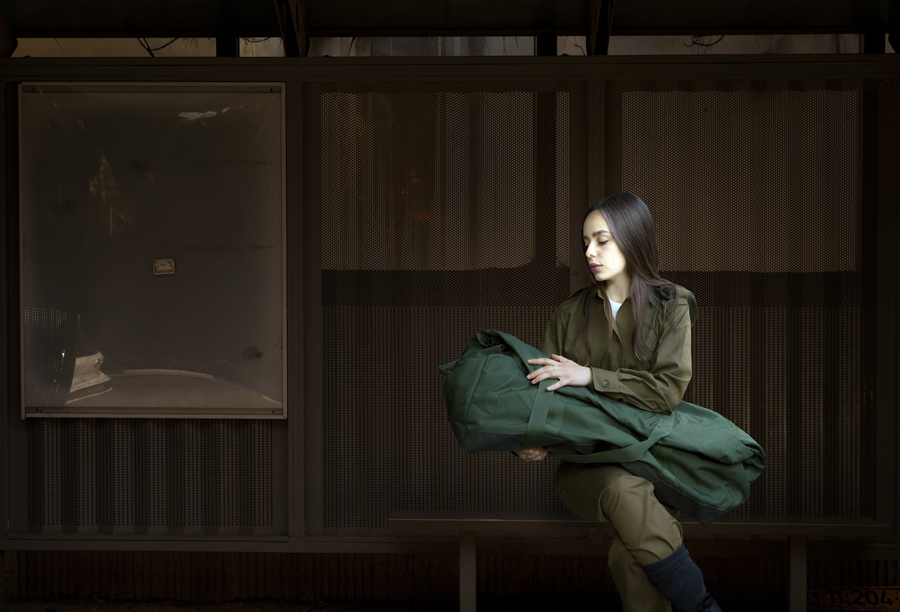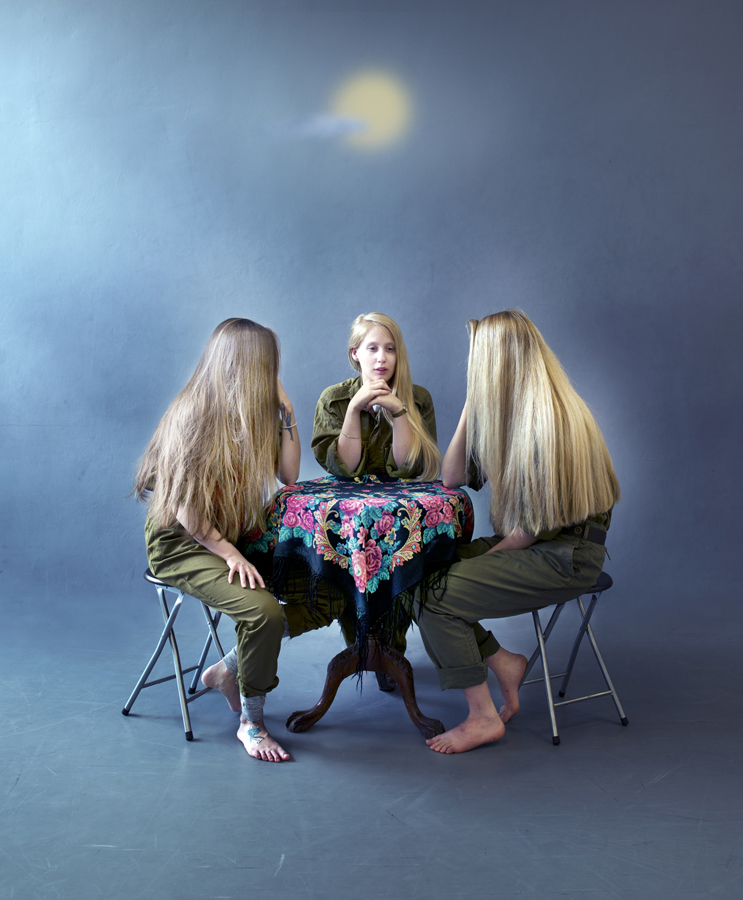The Song Of Deborah
(2016 - 2018)
“Angelika Sher presents a series of works that explore the mental and emotional changes in her daughter (Debby) and her daughter’s friends who enlisted in the IDF and on the fraught encounter of cultures, religions and histories. At the same time, the series also reflects the change that took place in the artist, who revisits issues that she explored when she was in the same place in her life as her daughter is now – both reflect on their role as women and human beings today. Military service is a significant milestone in the development of young people in Israel, like a rite of passage from adolescence to adulthood. Military service is associatively linked to power, heroism, and sacrifice for the collective – concepts that correspond well with the values of Pravoslav (Russian Orthodox) culture on which the Lithuanian-born artist was raised. Moreover, for new immigrants, the enlistment of a son or daughter to the IDF constitutes a seal of approval for an entire family, and the ultimate act of acceptance into the bosom of Israeli society.”
Ella Harel









![Roi [My Sheperd]](https://freight.cargo.site/t/original/i/6a719839c11715bd71e3b84258c1a20af88a2e3690447e71b4128f9c686b257b/ROI80X66.jpg)


![Matthew [When?]](https://freight.cargo.site/t/original/i/69f97a985371d22705221df7df5f08eee06e955b0724f40515c45be1004c9dd0/Matthew-90x160.jpg)
Exhibition @ Zemack Contemorary Art, Tel Aviv




The Song Of Deborah
Angelika Sher presents a series of works that explore the mental and emotional changes in her daughter (Debby) and her daughter’s friends who enlisted in the IDF and on the fraught encounter of cultures, religions and histories. At the same time, the series also reflects the change that took place in the artist, who revisits issues that she explored when she was in the same place in her life as her daughter is now – both reflect on their role as women and human beings today.
Military service is a significant milestone in the development of young people in Israel, like a rite of passage from adolescence to adulthood. Military service is associatively linked to power, heroism, and sacrifice for the collective – concepts that correspond well with the values of Pravoslav (Russian Orthodox) culture on which the Lithuanian-born artist was raised. Moreover, for new immigrants, the enlistment of a son or daughter to the IDF constitutes a seal of approval for an entire family, and the ultimate act of acceptance into the bosom of Israeli society.
At the same time that the artist is accepted into the collective she also separates from her daughter; the fabric of their relationship, portrayed in the artist’s previous series, changes. Control and power struggles are transformed with the shift into their new relationship – no longer an adolescent who tests her mother’s boundaries, but rather a soldier, whom from the moment of her enlistment was consumed by issues like independence, obedience, power, control, hierarchy and physical boundaries, which fill her world and her being. Her delicate and fragile baby is transformed by the uniform and the ranks. Her daughter, who was hers is no longer hers. Pride and anxiety intertwine.
The separation between mother and daughter is underscored by the difference in societal social norms. While young women in Lithuania are immersed in romantic thoughts about marriage and building a family, in Israel women their age carry a military duffle bag or weapon in their arms instead of a baby.
Angelika Sher’s rich visual world is deeply rooted in European art, to which she was exposed in her childhood. She uses Christian iconography to tell a story, to educate, and to control the viewer-devotee. Christian art iconography is canonical, symbolic and allegorical. Every order of colors, every detail and every figure has precise meaning, definition and convention of use. The same applies to the meaning behind each of the elements of the military – the ranks, emblems, units' insignia, military lingo, and the clear hierarchy. With familiar scenes from the history of art and names drawn from the New Testament, Sher plays and examines the change in the subjects of her photographs and her relationship with them, touching on notions of sacrifice, belonging, and separateness.
On the main wall of the gallery, like in a basilica of sorts, we encounter “Maria Orante” – one of the five canonical poses of Maria in the Russian Orthodox Church. Maria originally is shown in prayer, while here the figure is a soldier whose hands are raised, protecting/stopping, or perhaps surrendering in a horrifying allusion to the famous photograph of the Jewish boy in the ghetto. The soldier wears a military identification disk around her neck, evocative of the icons worn by devout Christians. The soldier's hand is decorated with a tattoo of a rose – one of Jesus' symbols – surrounded by the inscription: "Accept upon myself unconditionally” (a quote from the IDF oath), decorated with flowers, Stars of David and snowflakes. “Maria Ornate” is flanked by two archangels: Michael (the military commander) and Gabriel (the voice of the Creator). Originally, both are depicted as the same person, dressed in different clothes. In the photograph, they are portrayed by a young woman of conscription age. Like Gabriel, she is tough-looking: dressed in gothic clothes, her head shaved, and her earlobes gauged. But when she assumes the appearance of Michael, she looks like a thin and frail girl, dressed in IDF uniform that is too big for her, and the tough appearance is gone.
Beneath them there are two sheep, who are actually dogs disguised as sheep, symbolizing the holy lamb – the sacrifice. Self-sacrifice for the common good is the common denominator shared by Christianity and the IDF.
Throughout the years of acclimatizing and assimilating in Israel, she became more and more aware of the moral conflict in Israeli society regarding the nature of military service in a country that controls a civilian population that strives to gain independence. With time, Sher joins the ranks of many women in Israeli society who are worried about the implications of military service on the bodies and minds of our children, and wonder when and how the change will come.
The series closes with a triptych shot in Jerusalem – a city of conflict and strife, a place of an ongoing power struggle. Jerusalem symbolizes the arena of conflictual relations between religions, streams, and factions in Israeli society, and between women and men in the public sphere. Today we are witnessing a social struggle (#MeToo) led by women who are no longer willing to be victims. Women moving away from the passive, silent, and victimized position. Supported by the sisterhood of women, they lead a change in social perceptions and the behavior they imply, and signify that change is possible. The triptych is titled Dominica Palmarum (Palm Sunday), after the holiday that marks the arrival of Jesus to Jerusalem a few days before the Passion. At its center, Sher depicts Salvation – the Messiah, described as a poor man who will arrive on the back of an animal that serves as an agricultural tool and “not a weapon of war.” This Salvation (and in Hebrew – Geula, which is also a female name) will make the world a better and more just place, a world where peace, friendship, and comradery prevail.
As is common in many churches, before leaving the place visitors are given images that will lift their spirits and strengthen their faith. Upon exit, postcards await the visitors featuring a figurine of a female soldier, surrounded by banana decorations, hinting at the statement: "It is not spoiled, it's honey!"
Ella Harel